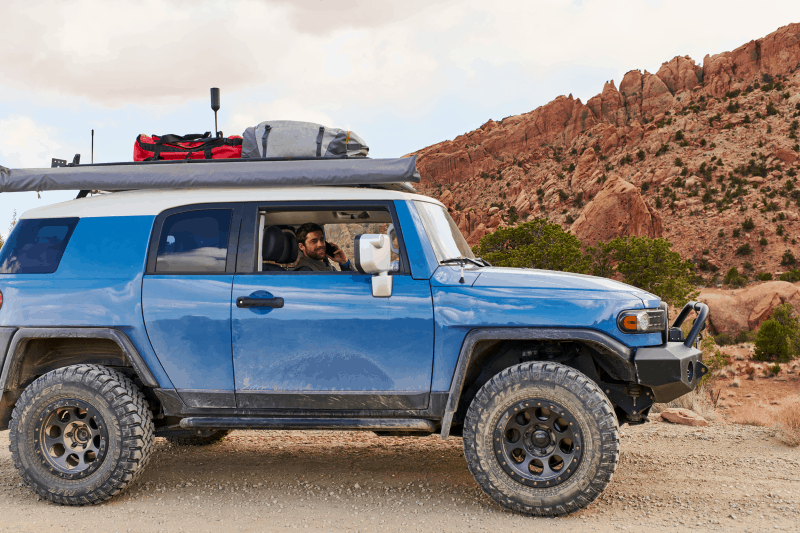Essential Overland Gear for Your Off-Road Adventure
Posted on 10/3/2023 by Meredith Pond

Traversing remote, rugged terrain few others have seen is one of the most brutal, yet exciting things an adventurer can do. Overlanding is about the thrill of adventure and exploring the world. Having the right overlanding vehicle is just the first step to making your trip fun and successful. There are many more steps to take and essential overland gear you must have to pull off such an adventure.
Overlanders put themselves and their vehicles to a survival test. While overlanding is becoming increasingly popular, it is not just another way to enjoy the outdoors and take a break from the bustle of the city. It’s not for the faint of heart, and certainly not for the ill-prepared.
Read on to discover all the essential gear and preparation steps you need to bear in mind before taking an overland excursion.
What to consider when choosing the best overland gear
Overlanding is not merely about the fun of discovering the outdoors, but also about self-sufficiency. Overlanding could be described as a type of self-reliant travel, in which the joy of the journey is more valued than the destination.
Here are some things to keep in mind when considering great overlanding gear for your next adventure.
1. Vehicle modifications
Preparing for an overland adventure begins with your vehicle. A sports car, family minivan, or overpowered muscle car just aren’t right for this kind of trip. You’re going to need a rugged truck or SUV to withstand the rigors of your trip and hold all your overland gear.
In fact, even most off-road vehicles including Jeeps, Tacoma trucks, and Power Wagons – at least in their stock forms – would need a bit more work before you could use them for overlanding. Here are some things to think about:
Go for big tires
The first step in getting ready for your overland adventure is to analyze the condition of the route you intend to take. You should then consider the weather conditions and ensure that you have the right tires for the terrain at its worst.
Big, aggressive 4×4 tires offer the advantage of more ground clearance and can more effectively tackle rocks, obstructions, mud, or wild thickets.
While big tires take a toll on fuel efficiency and may stress vehicle suspension, bearings, and steering, you’re going to need them on this kind of trip.
Get matching spare tires and jack
While driving on roads, you probably rarely think about your spare tire selection. However, when overlanding, you may need at least two spare tires that match the rest of your tires, plus a good jack that serves more than one purpose.
A good overlanding jack is designed to raise the vehicle to change a tire, but could also be used to get your vehicle unstuck in certain situations.
Raise vehicle suspension
There are many advantages to a raised suspension on an overland vehicle. The higher clearance makes it easier to crawl over rocks and avoid getting bogged down in mud.
You need to balance the need to keep your vehicle’s center of gravity as low as possible with the ability to clear rocks, brush, and other obstacles that are sure to be in your way.
Install good shock absorbers
Along with a suspension lift, overlanding requires reliable and rugged shocks modeled after racing vehicles. The right overlanding suspension for rough terrain should be designed to handle the high-amplitude and high speeds of off-road races.
Take the time to explore different shocks in the market, get advice from experts in that niche, and choose a shock system that fits the terrain you plan to conquer.
Add a roof rack
You could possibly do without a roof rack on your off-road vehicle, but they may make your whole trip more convenient. If your overland adventure will take more than a day, and you need to carry fuel, camping equipment, and other bulky items.
A sturdy roof rack may be the best overland gear you can invest in. Besides carrying the bulkier items you need, a good roof rack is also a layer of protection in case your vehicle rolls over.
A roof rack can also keep essential gear and off-road accessories from affecting the space and comfort inside your vehicle.
2. Camping gear
What you need to camp during your overland adventure depends on several factors. Among the most important are:
- How mild or wild you expect the excursion to be
- Your budget and comfort level with “roughing it”
- How much load your vehicle can bear
Here are some essential pieces of camping gear you’ll need for your overland trip.
Tents for you and your vehicle
You probably already have a camping or backpacking kit. This will help shelter you and anyone else you take along the overland adventure. However, don’t forget that your vehicle, too, may need protection from the elements. Consider rooftop tents that connect to the top of your vehicle.
Camping shower and toilet
Don’t overlook the importance of preparing for the bathroom in the wild. Be ready with a simple shower jug and bathing suit to wear while showering, so you can get cleaned up while other people are around.
You should also get a low-tech toilet solution, unless you plan to dig a latrine every time you need one. In the latter case, be sure to have a shovel handy.
Campsite power and lighting
You will need a way to recharge your devices, light up your campsite, and have emergency power for other uses while out in the wild. There are many solutions to this challenge, but a portable generator or portable power bank might be the most practical. Consider a solar power station with solar panels for recharging.
3. Tech essentials
It’s possible to explore the wilderness with just your off-road vehicle, a sleeping bag, and some food and water. However, having a few high-tech off-road accessories can greatly enhance your experience.
Here are some essential tools you should consider adding to your overland gear.
Navigation tools
Many satellite GPS navigation gadgets today can work anywhere on earth if the sky is clear. However, to be on the safe side, you should have both digital navigation tools as well as paper maps and a magnetic compass.
You should also invest in good guidebooks. These will help you understand overland travels, identify and avoid dangers, and provide tips to navigate rough terrain.
Cell phone signal booster
While overlanding is a great way to disconnect, most would agree that it’s wise to have a way to get in touch with civilization in case things don’t go as planned.
Of course, you can take your phone with you, but keep in mind that you’ll most certainly be far away from cell towers. Since network coverage in the backcountry tends to be unreliable, you’ll need a cell phone signal booster to make your devices work.
An overlanding cell phone signal booster makes weak cell signals usable by reaching faraway cell towers, boosting the signal, and then broadcasting that stronger signal to nearby devices, such as phones and navigation tools. This allows you to use your phone or even a hotspot. A booster could make the difference between being able to get in touch with civilization and being totally on your own.
4. Lifestyle and comfort necessities
You will need these items to make your adventure fun and comfortable going into the backcountry:
First-aid kit and basic training
A first aid kit is a must-have for overlanding. There are countless brands of kits already packed with all the medicines and medical equipment you may need out there.
But having the kit isn’t enough. You must also take the time to learn a few basic first-aid techniques, such as cleaning and bandaging cuts, relieving heat stress, and draining blisters. Make sure that everyone who is a part of your group remembers to bring enough of any necessary medications to last the entire trip.
Clothing and protection
Imagine the worst-case scenario when packing clothing for overlanding: your vehicle is stuck or the engine is dead, and you must abandon it and walk for days to reach the nearest town.
Suddenly, you are not an overlander but a hiker. In such a case, you will need weather-proof clothing with thermal and waterproof layers. Be sure to pack hats, sunglasses, and a good pair of hiking boots for both planned exploration and unexpected hiking.
Camping tables and chairs
One of the most memorable pleasures of your overlanding experience will be the time spent at camp. Elevate this experience by packing the right chairs and tables to cook, eat, and hang out more comfortably.
Sleeping essentials
Beyond having a shelter over your head, you will also need gear to keep you safe from the elements to sleep comfortably. Sleeping bags or pads are made for different conditions, so be sure to find one ideal for the kind of overlanding you are planning. You’ll also want to pack a sleeping pillow and extra blankets for additional padding and warmth.
A bag for all your stuff
It is easy to lose or damage all the stuff you need for your overlanding adventure. While you need to be minimalist when deciding what to take with you, a good bag to keep all the important stuff safe and organized is essential.
Outdoor expedition bags are designed to accommodate all the stuff you need and to protect them from heat, water, and abrasion.
5. Food storage and cooking gear
You’ll need to include some camp kitchen supplies in your overlanding gear. If you’re only out with a few people for a few days, your kitchen pantry can be light and minimalist. However, for long haul overlanding, you will need to make more detailed plans.
Here are the essentials you need to consider.
Food
Plan for food based on the size of your party, the length of the excursion, and reliable resupply points along the route. If the entire adventure is through the wilderness, consider including a camping grill or stove and more than enough food in your overlanding pantry.
Prioritize dried foods and non-perishables that you can pack in plastic containers or grocery bags, such as rice and pasta, but do not forget snacks, fruits, and vegetables. When planning your menu, consider how much cooking you’ll want to do as well as how much fuel you want to take with you.
Water
Consider a worst-case scenario when planning your trip, especially when it comes to water. If you were to get stranded, you could survive for up to a month without food as long as you have water, but only a week if you don’t have water. Even if there are natural water sources nearby, take enough water to last a few days with you and pack a water purifier for resupply.
Cooking essentials
Cooking over a campfire works for some. However, you might not always be willing or able to build a fire. For those reasons, a camp stove can be easier and more reliable.
Look into butane or propane stoves. And don’t forget other cooking and eating items such as spatulas, tongs, knives, plates and bowls, and cutlery.
Wrapping up
Preparing for your first overlanding excursion can be intimidating, especially if you plan to be gone for a while. However, if you’re doing it right, the excitement should begin at the preparation stage.
Of all the things you need to do to make the adventure a success, the ability to stay in touch with loved ones and reach out for help in case of emergency is the most important. While you’re making plans, it will be worth your time and effort to get an overlanding cell phone booster you can trust.
Visit weBoost.com to explore their range of market-leading cell phone boosters.



